|
|
|
|
|
|
|
We are super stoked to host the 2017 Reel Paddling Film Festival at the Blue Mouse Theatre in Tacoma. Since 2006, the Reel Paddling Film Festival World Tour has been showcasing the very best paddling films. The World Tour screens in more than 120 cities around the world. Join us for this year’s best paddling films. You’ll be inspired to explore rivers, lakes and oceans, push extremes, embrace the paddling lifestyle and appreciate the wild places.
Show Starts at 7pm at the Blue Mouse Theater in Tacoma.
If you aren’t familiar with the tour, check out the trailer below.
The show starts at 7 p.m. on April 20th. Tickets are $12 at Gig Harbor Watersport or Gig Harbor Watersports. Or, for $15, you can purchase at the door or from our website.
If you have any other questions, give us a shout at the store. 253-358-3189.
What: Public hearing for Occidental Chemical cleanup
When: 5pm (open house) and 6pm (public hearing) on Wednesday, March 8th
Where: The Center at Norpoint (4818 Nassau Ave NE, Tacoma)
Facebook: www.facebook.com/events/187450521741965/
It’s no secret that Commencement Bay carries a toxic legacy. While we have made real progress since the fish-less waters of a few decades ago, one polluted mess in particular serves as a reminder of how much further we must go in our pursuit of healthy waters (and healthy fish). That mess is the Occidental Chemical Corporation Pollution Plume.

Photo: Occidental Chemical site in operation; Credit: Occidental Chemical Corporation
For nearly 100 years, Occidental Chemical Corp. manufactured a slew of chemical solvents along the shores of the Hylebos Waterway in the Tacoma Tideflats. Although the company no longer operates here, they left behind a mind boggling amount of these hazardous chemicals in the soil and groundwater below the site, creating an enormous toxic plume.
The cleanup process for this underground pollution plume will be an immense undertaking. For starters, the size of the contamination is staggering. It spans an area the size of five CenturyLink Field stadiums and reaches a depth of 160 feet, or about as deep as the Tacoma Dome is tall. It contains a mixture of extremely dangerous pollutants, including metals, PCB’s and a particularly nasty group of volatile organic chemicals. Over time, these pollutants can release cancer-causing gas into our water and air. In fact, the pollution is so toxic that it is dissolving hard rock into jelly. If the pollution can dissolve rock into jelly, just imagine what it can do to the salmon, birds and other wildlife in Puget Sound.

Photo: Pollution plume from Occidental Chemical Corp.; Credit: WA Dept. of Ecology
The severity of Occidental Chemical’s pollution landed the site on the federal list of Superfund cleanups in the early 1980’s. Decades later, we are finally examining different cleanup options for the site. Right now, officials from the Washington State Department of Ecology are deciding on a cleanup plan. The plan they settle on will determine how much of Occidental’s mess gets removed and how much stays in the ground forever.
This stage of the cleanup is where things get tricky. Historically, the parties responsible for the pollution on Superfund sites help foot the bill for cleanup costs. However, Occidental Chemical wants to pay as little as possible for the cleanup and walk away from their toxic mess with the vast majority of the pollution remaining in the ground. This is absolutely unacceptable – Tacoma and Puget Sound deserve better. We cannot afford to put the profits of polluters above the health and safety of our environment and fish. That’s where you come in.
The Department of Ecology is holding a public hearing on Wednesday, March 8th, which will be our best chance to speak out and demand the strongest possible cleanup plan from Occidental Chemical Corporation. Tell your friends and show up for the health of your fish and local waters!
What: Public hearing for Occidental Chemical cleanup
When: 5pm (open house) and 6pm (public hearing) on Wednesday, March 8th
Where: The Center at Norpoint (4818 Nassau Ave NE, Tacoma)
Facebook: www.facebook.com/events/187450521741965/
If you can’t attend, you can still help by submitting public comments. Send your comments urging the strongest cleanup possible to:
Kerry Graber, Site Manager
Washington State Department of Ecology
PO Box 47775, Olympia, WA 98504-7775
Kerry.graber@ecy.wa.gov
For information regarding the cleanup of the Occidental Chemical site, visit our website at http://www.healthybay.org/occidental-chemical-cleanup-site/
With questions or to receive updates on this issue, email Ryan Cruz at rcruz@healthybay.org
About Citizens for a Healthy Bay
Citizens for a Healthy Bay engages people to clean up, restore and protect Commencement Bay, its surrounding waters and natural habitat. We have been involved in the Occidental cleanup process for nearly two decades. As the local clean water leader, we will continue bringing people together to achieve a clean and healthy Commencement Bay that benefits both our community and the surrounding ecosystem.
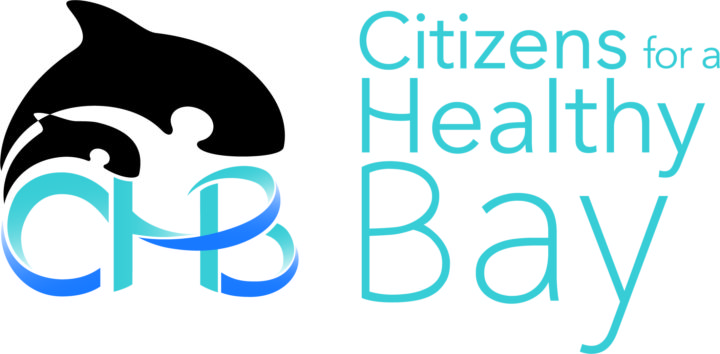
We are hosting a Hobie Kayak demo day on Saturday, March 25th. If you’ve been curious about the relative merits of the Pro Angler 12 versus the Pro Angler 14, this is the perfect time to come compare and contrast. For free!
We will have all of our Hobie demo kayaks on the water for you to try. These boats fishing machines, but are also fantastic for recreational boaters and paddlers with shoulder problems.
We will have the grill fired up, and plan to make a day of it! Drop by the store and see us.
If you have any questions, give us a call at the shop: 253-358-3189.
Check out the Facebook page for the event as well and let us know you’re coming.

We are super excited to bring Kokatat dry suits into our shop. Kokatat is the world leader in dry suits, and we couldn’t be more pleased to carry their products.
Recently, Kokatat released a GORE-TEX version of their popular Supernova Angler suit. This suit is a front entry fishing oriented paddling dry suit. For all day comfort, Kokatat has replaced the tradition latex neck gasket with a neopreone neck gasket. This gives the wearer more comfort on the water, while still providing excellent protection against the elements.
The suit is built with 3-layer GORE-TEX fabric, and is re-enforced with military-grade 330 denier GORE-TEX Codura fabric in the lap, knees, seat, and elbows to help it withstand years of use and avoid hook snares. The front relief zipper is covered to protect your catch as you bring it into your lap.
The suit sports a draw cord waist, latex wrist gaskets with adjustable hook and loop cuffs, and built-in GORE-TEX socks with gravel guards. It is available in red and acorn colors.
The suit is available from a small to a XXL. If none of the pre-made sizing work for you, Kokatat can make custom suits to fit you personally. Just come in and get measured for it!
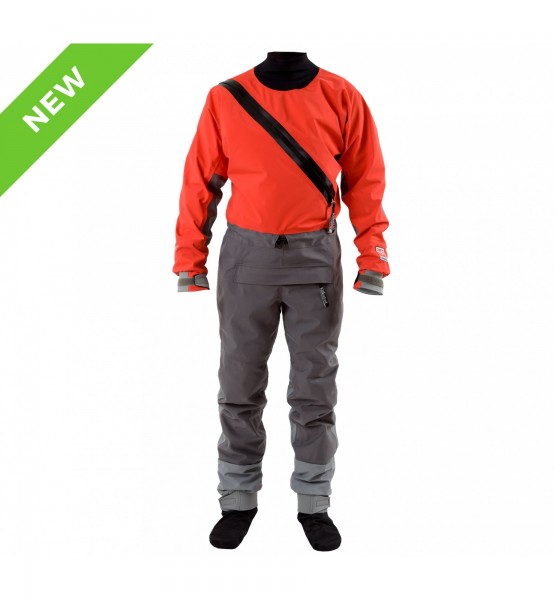
GORE-TEX SuperNova Angler Suit in Red
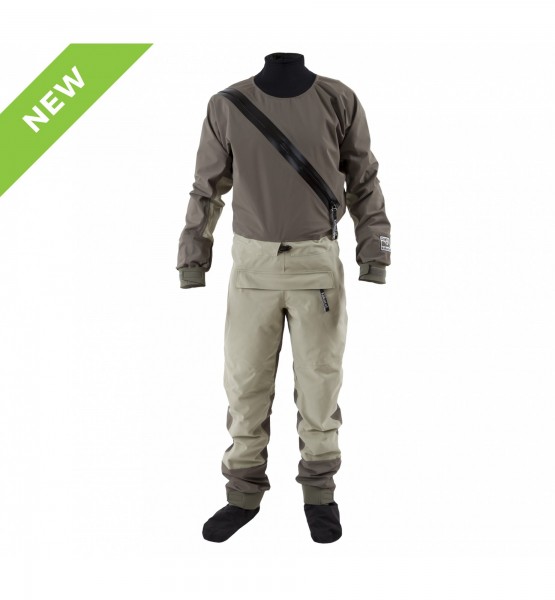
GORE-TEX SuperNova Angler Suit in Acorn
We are also bringing in the extremely popular traditional Hydrus 3L Supernova Angler paddling suit. Instead of GORE-TEX base, this suit is built with Kokatat’s proprietary durable 3- layer waterproof breathable Hydrus 3L fabric. It offers Cordura reinforcement on the lap, seat, knees, and elbows, as well as the neo cinch neck featured in the GORE-TEX Supernova.
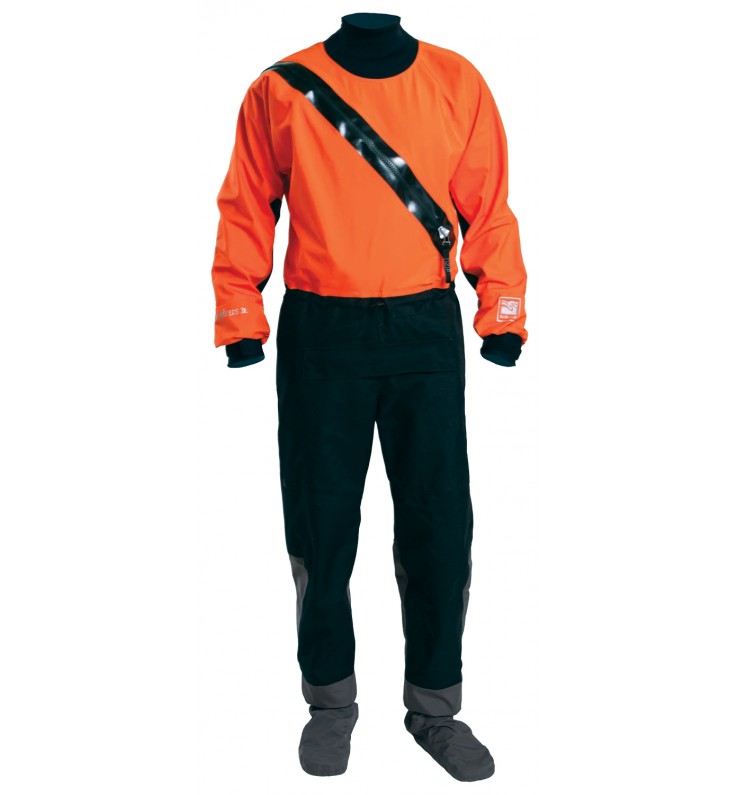
Hydrus3L SuperNova Angler Suit in Tangerine
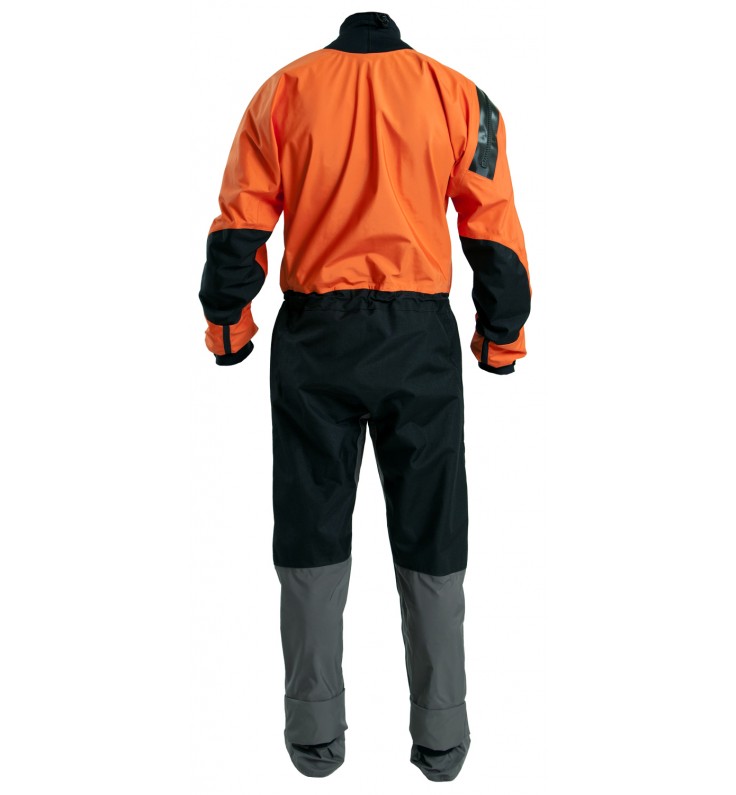
Hydrus3L SuperNova Angler Suit in Tangerine
Both suits are backed by Kokatat’s limited lifetime warranty against defects in materials and workmanship. There’s a helpful care guide on Kokatat’s website to help you get the longest life out of your suit without having to send it in for repairs. If you do have to send it in, Kokatat has astate of the art repair and retrofit facility in California for when things need a patch, or you simply want to add a hood to your dry suit.
Drop by and let us fit you for adventure no matter the weather.

One of the coolest things about a Hobie Kayak is that there is an option of adding a Hobie Kayak Sail Kit. All of the Hobie’s we sell, come with a spot for mounting the sail.
If you’re curious about how to set up the sail kit on the kayak, Hobie has an excellent how-to guide. We converted it to pictures below. If you want to really explore the document, follow THIS LINK for the full sized PDF.
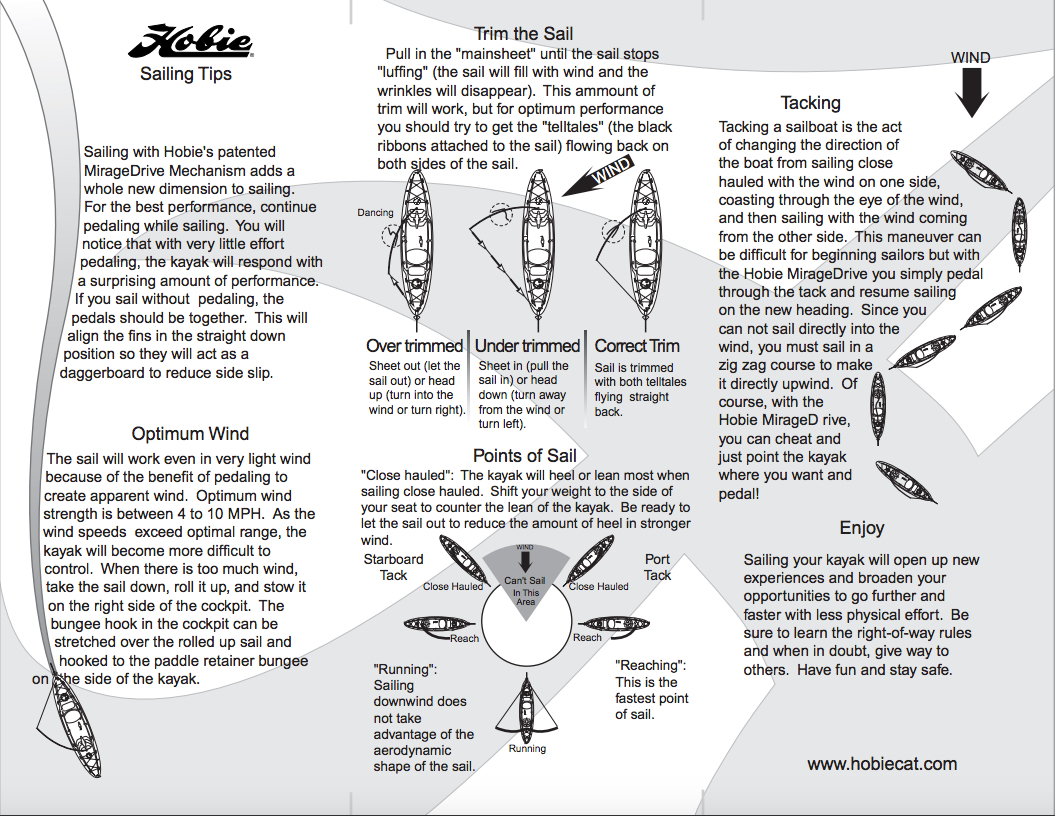

For the recreational paddler, this is another fun way to use your Hobie. If it’s a mildly breezy day, it’s a great day to sail a Hobie. The optional sail kit gives you the ability to sail a boat that you can already paddle or peddle. Now you can try all three in a single outing.
For the serious fisherman the sail kit offers a ton of extra support. Some of our kayak anglers are pushing miles into open water or covering miles of shoreline as they fish in the Puget Sound. By adding the sail kit, you allow the wind to give your legs a much needed break. After a full day of exercise, making that final push back to the take-out point can be brutal. The sail kit gives you a boost, even in boats as big as the Pro Angler 17 Tandem.
Hobie also makes an inflatable ama to add stability to the kayak. These can be used when sailing, or just to give the kayak extra stability for fishing or other activities. These are especially useful if you have one of Hobie’s slimmer boats such as the Revolution series.

The Sidekick Ama
If you want an idea of how fast these kayaks move with the sail attachment, then head over to our Youtube channel. We made a compilation playlist of folks sailing Hobie kayaks just for curious readers like you.

The Bay of Fundy in Maine has the highest tidal range in the world.
If you paddle in the Puget Sound for long enough without understanding and paying attention to the tides, then you will eventually end up looking longingly at your truck from across a giant, impenetrable mudflat. Maybe you’ve been lucky and avoided this fate so far. Understanding the tides is the difference between getting stranded and paddling home with the tides on your side.
Understanding the tides is also bound to help your fishing. Good fishermen use their knowledge of how fish react to tides to maximize their time on the water. No one wants to fight the tide coming home after a long day on the water. Tide predictions are a powerful tool for an informed sportsman.
So, how do tides work, and how can you get the information you need to make informed decision about the tide for any particular day? Let’s kick this off by going over that section on tides you may have slept through in 8th grade science class.
What are tides?
In short, tides are the result of how the moon, the sun, and the earth interact.
The major player here is the moon. The moon exerts 2.2 times the gravitational pull on the earth as the sun, even though the sun is larger. This is because of how close the moon is to the earth.
The moon’s gravitational pull causes the ocean closest to the moon to be pulled towards the moon. The ocean on the far side of the earth is not nearly as affected by this pull. In turn, the center of the earth is being pulled towards the moon harder than the ocean on the far side from the moon, but less hard than the ocean closest to the moon. This uneven gravitational pull creates what’s called a tidal bulge. Add the earth’s rotation into the gravity soup and you create a tidal bulge on the opposite side of the earth from the moon.

How Stuff Works really gets into this in their video below. It’s worth the quick watch. The visuals help in understanding this concept quite a lot.
The sun works either in tandem with the moon, or against it. If the moon and the sun are both lined up, then they multiply their pull and you have a super high tide called a “spring tide.” These tides happen on a full moon or a new moon.
If the sun and the moon are at right angles to each other they dampen the gravitational pull of the other, creating a super low tide called a “neap tide.” Neap tides happen on the quarter moons.
This is why many tides and current charts include full, new and quarter moons on their calendar. If the fishing is best during a spring tide, you can pin down exactly when that is and be at the right place at the right time.
The earth and moon are constantly moving around each other. Because of these movements you get a high tide on average every 12 hours and 25 minutes. This number changes dramatically in different areas of the world based on the coastal features around you. Some areas only get one high tide a day.
If you really want to take a deep dive into the physics of all this, PBS has a great video on their channel:
READING A TIDE CHART
So, how do you know what sort of tides are in your area? A good place to start is through the National Oceanic and Atmospheric Administration’s (NOAA) website. There are many websites out there that give you a really stripped down version of what you’ll see through NOAA, and those are great for a quick reference. But if you really want to dig down into reading a tide chart, then there isn’t a better source than from the guys who collect the data.
When you get to site, navigate to the area that you are interested in exploring. Click on the nearest station. This will pull up a slew of information. You can get info about water temperature, predicted tides, and actual height in the past or at the present moment.
A few things you’ll note about the data it does pull up (we took a screenshot shown below). First, the times are marked in the military time 24-hour clock. This means 0:00 is midnight, 12:00 is noon, and 22:00 is 10:00 pm.
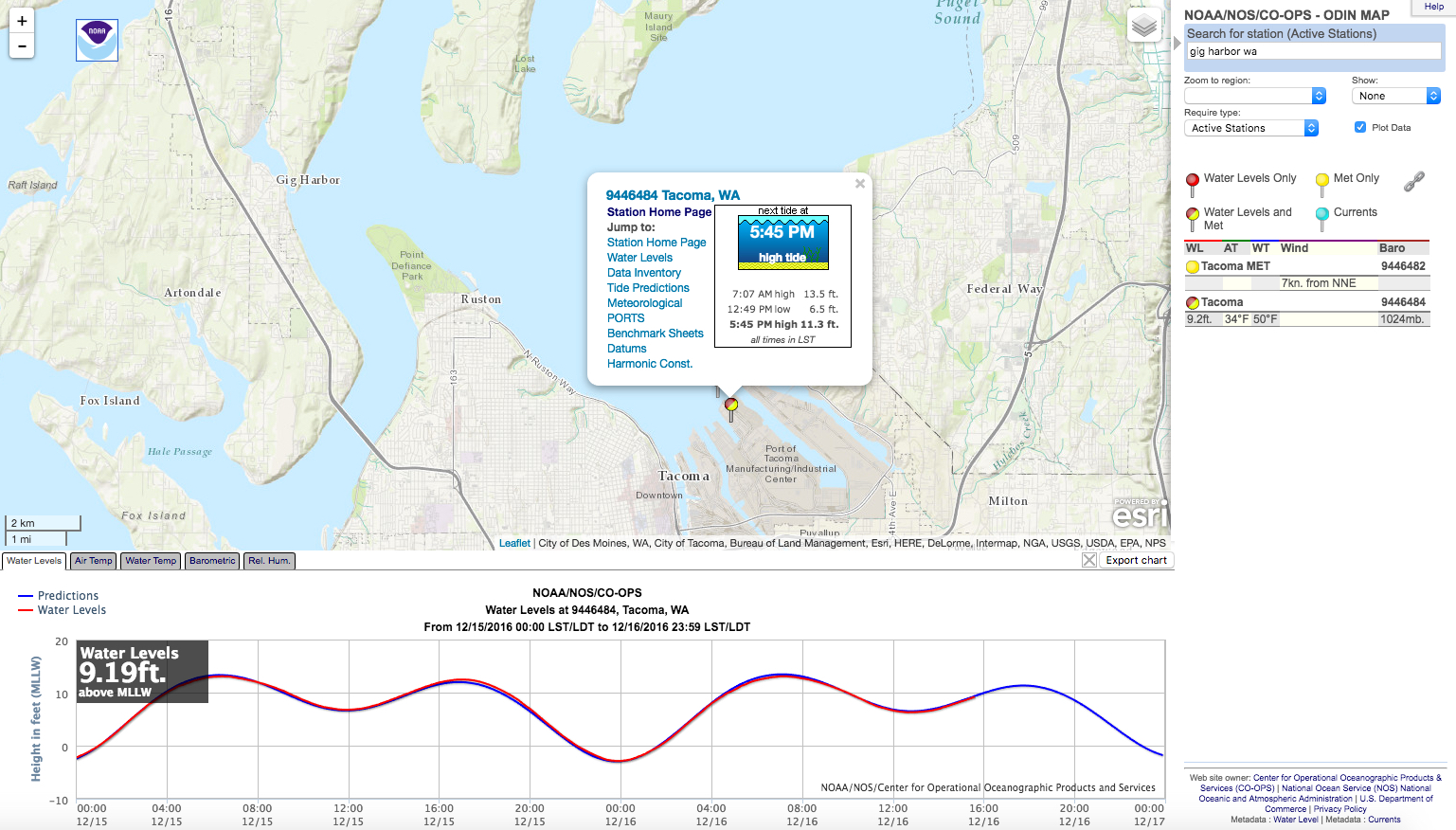
The chart from NOAA.
When we pulled up the data to write this blog post, the water level was at 9.19 ft above MLLW. The NOAA uses “Mean Lower Low Water” (MLLW) as the baseline for their graphs. MLLW is a type of datum that uses the average height of the lowest tide recorded at a tide station. Depending where you are in the world, there may be different types of datum used. Here’s a guide to all the types used world wide, so you can plan that fishing trip on the other side of the world.
In this area of the world (Gig Harbor, WA), the charts you read will likely be in MLLW. Because MLLW is an average of the heights of the lowest tide, you will often see low tides listed as a negative number.
For instance, the low tide for 12/15/16 at 0:00 was -2.251ft. The high tide at 6:20 was 13.313ft. That means that from low to high tide, there was a tidal change of 15.564 feet. That’s a pretty big difference in six and half hours. If you had paddled up to a beach at midnight, dragged the boat up a dozen yards onto the beach, and fallen asleep without anchoring the boat down with a pretty long anchor line, you could easily have woken up six hours later to a missing boat.
This basic system is used in many of the website or hardcopy charts and graphs you will find. Many folks use mobile apps to track the tides and currents. A few other popular websites our staff uses are Pro Tides and Saltwater Tides. A few app suggestions are the AyeTides App or the My Tide Times App, although there are hundreds of apps and mobile ready websites to help you make informed choices. Visit a few websites, download a few apps, and see which platform gives you the access to information you need in a way that works for you.
Sturgeon 180? I’ll explain…
Dec 11th was the 3rd annual Sturgeon Social on the Willamette River in Portland. Roughly 30 kayak anglers in all the popular manufacturers/models were in the meat line beckoning a sleigh ride. Brad Hole of Kayak Fishing Washington and myself were the only two equipped with Hobie’s new 180 drive. First impression of the drive was solid with a slightly different feel over prior models. Reverse seemed novel at the time, but this opinion would soon change…
Sturgeon can be sizable, and handing them in a shipyard packed with structure was a feat in its own. I witnessed fish after fish lost to floating buoy lines and a partially submerged wall of a massive dry dock. Sturgeon aren’t big fighters like salmon, tuna, or jacks, but they are heavy and built with a broad heterocircle tail keeping the pressure on! The majority of fish were hooked on the edge of the dry dock, and would often run straight underneath. Without the ability to reverse most anglers were at the mercy of the fish. This is where the 180 was worth its weight in safely released dinosaur!
Once the hook was set, I was able to maintain a rod position and line angle optimal to rapidly land and safely release several fish by utilizing the reverse function. Distancing the kayak from obvious structure took only a little forethought and coordination opposed to fighting my boat and the fish in concert. The 180 drive will immediately appeal to bass fishermen and small water anglers for good reason. I learned quickly that it shouldn’t be overlooked by the big game/big water crowd either. The experience has left me brainstorming innovative new ways to utilize this tool.
As for sturgeon fishing itself: Sturgeon are in no way a predator. They have large sucking bucket shaped mouths underneath a long nose. They locate potential food sources via smell, then pinpoint further with barbels under the nose.
The take is very light and subtle, especially for a fish of that size! It’s really just a faint tap’tap. A relatively sensitive rod shows it best, but must also have a stiff backbone to handle/rapidly (as possible) land a fish potentially weighing triple digits. Let me further complicate the situation… Most state fishing regs require a barbless hook. If they don’t, you should use one anyhow to aid in release, but that’s another topic… With that said, a somewhat flexible rod will help maintain a deep bend and keep steady pressure holding the hook solid.
The rig is quite simple. A main line of heavy braid (50lb or higher), enough lead to hold the bottom attached to a slide on your main line, leader of 30lbs or higher at 18-24”, with a 3/0-6/0 hook depending on your bait of choice snelled to the business end. Bait ranges anywhere from night crawlers, to shrimp, squid, herring, or anything between! They’ll often show a preference of one over another, so the successful angler should have a few offerings.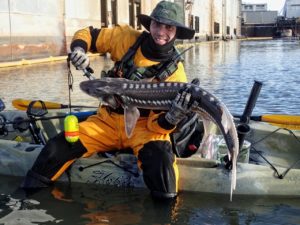
Although large, sturgeon can be quite fragile. Small fish should be properly supported by the base of the tail and near the pectoral fins/front of body for a quick photo. Truly big fish should not be removed from the water. Large fish can be grabbed by the bucket like mouth, and base of the tail. They should not be lifted by the mouth or tail alone though to protect their spine. A quality pair of grips such as Lucid, and/or a dependable partner are helpful in handling fish over 3’. This will also help avoid the sharp bony scutes along the back, belly, and sides.
Sturgeon fishing is a ton of fun, and open year round for C&R with a few short retention season in select areas. If kayak big game fishing appeals to you, this can be a great relatively safe way to cut your teeth or hone your skills. Tight lines, and good luck!
Once you’ve bought a Hobie kayak, you’re going to have thousands of different customization options at your fingertips. Which ones are worth the investment?
This is a quick list of the five most common upgrades our customers gravitate towards. We’ll break down the advantages of each.
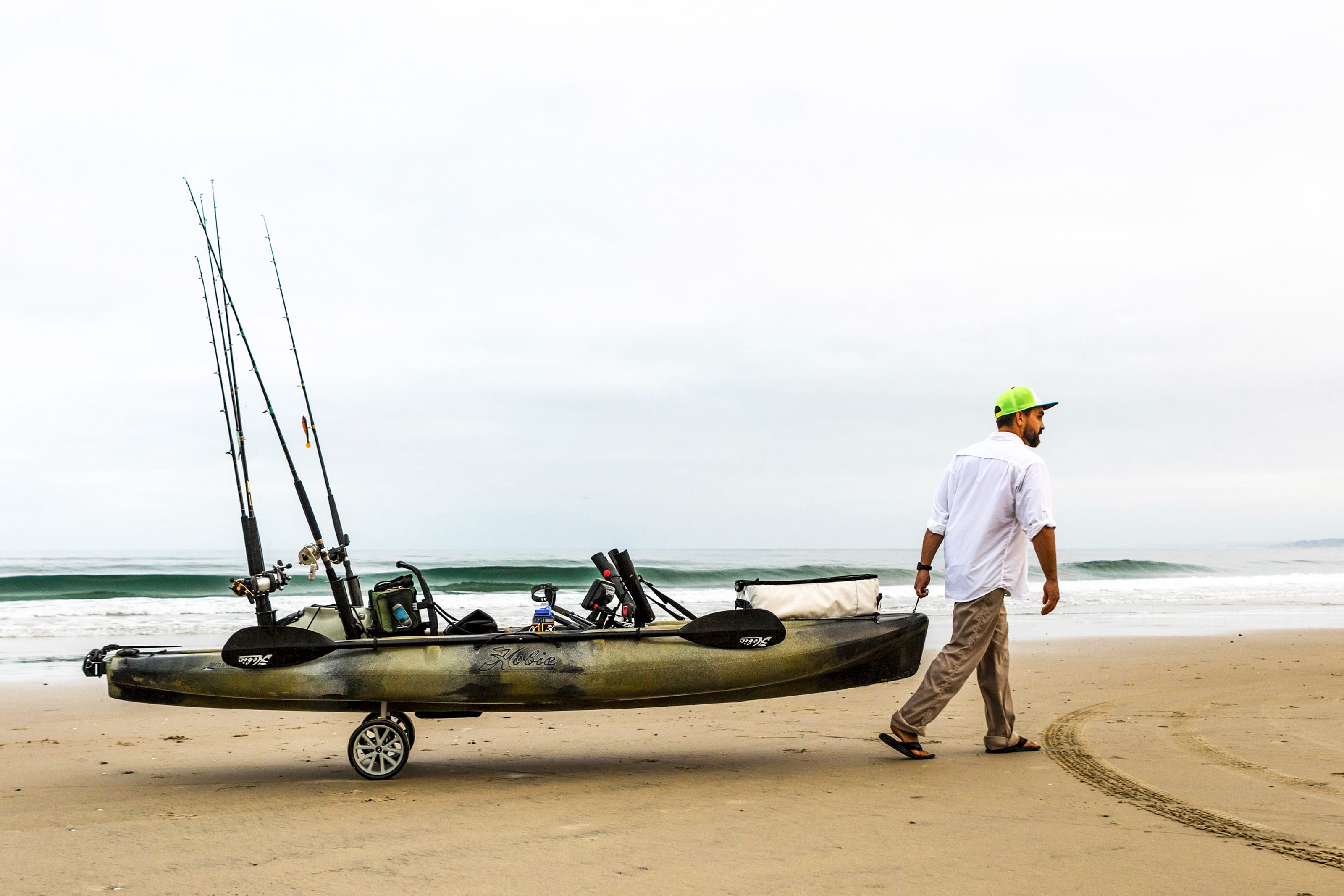
A rigged Hobie Outback in Camo with the stow and fold cart.
1) Rigging
There are hundreds of ways to rig a kayak. We sell Hobie, YakAttack, and RAM Mounts systems to help you figure it out. Many of these brands are interchangeable. The first step is to find a mount system to build on to.
If you bought a Pro Angler, Hobie makes many H-Rail specific accessories. These just clip onto the H-Rail and are ready to go. They can be easily removed or adjusted. It’s a great place to start if you have a Pro Angler.
If you bought another Hobie model (or any other kayak for that matter) then you still have tons of options. Our suggestion is to start with a YakAttack Geartrac. These handy tracks come in a variety of sizes, starting at 4” long. This allows you to mount a variety of gear using their track system. Once this system is installed, you can add rod holders, paddle leashes, safety flags, or any slew of specialized gear. Yak Attack has a great Youtube Channel to help you rig the perfect kayak.
2) Turbo Fins
If you bought a Pro Angler, your boat came standard with Hobie Mirage Drive’s Turbo Fins. If you have a standard fins (ST Fin) which come standard with most boats such as the Revolution series or Outback, then you can easily upgrade to Turbo Fins. This means that each pump of the Mirage Drive drives you further. This is possible no matter what year Hobie kayak you own. The original fins and ST Fins can both be updated to a Turbo Fin. The brand new 2017 Mirage 180 Fins can also be upgraded to a Mirage 180 Turbo. Hobie will be releasing these in Spring 2017.
3) Sailing Rudder
For smaller boats like the Revolution series or the Outback, replacing the standard rudder with the much larger sailing rudder will make a marked difference. The larger rudder gives added maneuverability and finesse to your boat. A Revolution 13 with added Turbo Fins and a Sailing Rudder will go further with less effort, and react to your controls instantly. Many people consider this a must-have upgrade to get the full potential out of several Hobie kayaks.
https://youtube.com/watch?v=X8n5CQxjuGY
4) Plug-In Cart
The Plug-In Cart is another must-have essential, especially if you’re transporting your boat by yourself. The cart plugs into the scupper holes on the bottom of the kayak, allowing for easy transportation. The cart is available in a variety of wheel types. The two most popular are the rugged and the beach wheels. The large rubber beach wheels allow the cart to stay above the sand during transportation. If you’re mostly launching from hard packed or paved areas, the rugged wheel set is probably for you.
Recently, Hobie released a foldable wheel set. Check out their promotional video for more info on the super transportable wheels.
Shop our entire selection on our website.
5) Anchor Trolley
Pro Anglers come pre-drilled for this add-on. This simple pulley system allows you to stake out or anchor your boat in shallow water and adjust the point of contact to get a perfect position in the water. In the Puget Sound, the water is often too deep for a stake out pole or an anchor. Hobie makes a drift chute, however, that can greatly aid fishermen as they fight for good positioning. An anchor trolley is an incredibly simple install on a Pro Angler. Other boats require drilling, but this is easily done with rotomolded boats and a drill bit.

A properly working PFD can save your life. It’s vitally important to maintain your PFD over the years and to know when it is time to invest in a new one.
First, it’s important to give the PFD a wash with fresh water after a day on the water, especially after an outing on salt water. Even if you were on fresh water, however, salt can build up via sweat. Give it a wash. If needed, use a mild soap and rag to wipe down the PFD.
Second, make sure to hang dry the PFD before storing it. Many standard flotation devices are made of foam that can break down more rapidly if stored wet and inundated with saltwater.
Third, once the PFD is dry, store it in a shaded, well-ventilated location. UV light from the sun can significantly shorten the lifespan on a PFD if left to bake on the side of the house.
We suggest hanging them, if possible. This keeps the likelihood of the PFD getting stuffed in a corner, sat on, etc. to a minimum. Many types of mold find the foam in PFDs to be the perfect breeding ground. Hanging in a storage closet or somewhere similar is the best way to ensure a long life for your investment.
Even a well cared for PFD eventually needs to be replaced. A sun faded PFD should be closely inspected. Just because it’s sun faded doesn’t mean it HAS be replaced, but it tends to be a first sign. You should inspect the foam and make sure that it is not brittle and hard. If you compress the foam, it should quickly return to its original state. If it doesn’t, it is probably time to invest in a new PFD.
Lastly, don’t sit on, or in any other way compress the PFD. If you can’t hang the PFD to store it, make sure that it isn’t stored under anything that might slowly compress the foam.
Are you thinking your old PFD might need to be retired? Bring it in to us for a second opinion and quick inspection.*
*Please note, we are not certified by the US Coast Guard to officially inspect and verify the safety of used PFD’s. Our rule of them, just like leftovers in the fridge, when in doubt throw it out.
 I’ve worked with the Gig Harbor Fly Shop for years, guiding from kayaks, fishing from kayaks, and selling kayaks. Now with the opening Gig Harbor Watersports we are able to bring in many new styles of kayaks and paddle boards.
I’ve worked with the Gig Harbor Fly Shop for years, guiding from kayaks, fishing from kayaks, and selling kayaks. Now with the opening Gig Harbor Watersports we are able to bring in many new styles of kayaks and paddle boards.
Hobie 12.6 Tour Inflatable
One of the big misconceptions I had over the years is that inflatable watercraft are fragile or are going to be punctured with normal use. This certainly can happen, however it is pretty unlikely. My first instinct when someone ask about a inflatable kayak or paddle board has always been “Stop! You don’t want to invest in that!” and make no mistake, there are a lot of inflatables on the market that made me think that.
However, Hobie and Bote changed my mind. When we brought in Hobie we were pretty quick to ignore their inflatable series of kayaks and paddleboards. We actually ignored inflatables for the first year we had them in the shop and the overwhelming amount of questions and special orders we had for them changed our mind and made us give them a chance. Here is why.
1.) Drop Stitch Flooring – With Hobie’s “Drop Stitch Floor” you loose the feeling of being on a inflated floor. The Drop Stitch flooring allows the user to use enough air pressure to create a rigid base. Previously I had imagined a very flimsy unresponsive base, and with drop stitch flooring this is just no longer the case.
2.) Weight – Many of Hobie kayaks are significantly lighter than their molded counter parts. Meaning if you are having trouble getting a 80lb kayak on top of your car or truck, the weight you save from the inflatable could be your best bet for a stable sit on top option!
3.) Storage – This is the pretty obvious reason to own a inflatable… you can deflate it and put it in your closet or trunk. With an electronic or large pump you can inflate most of these with very little effort. Storage is one of the major reasons many people are buying inflatables. Many of these inflatables can even be checked on a flight so you can bring the fun with you wherever you go.
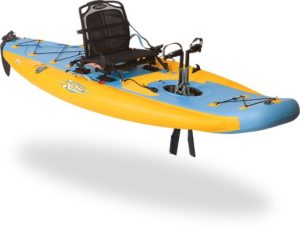
Hobie’s i11s Inflatable Sup/Kayak Hybrid
4.) Features – Most folks think that they will sacrifice features to get an inflatable, but many of the same features and some extras are able to fit into the inflatable platform! Bote Boards even allows for a stakeout hole, and tackle management in their inflatable paddle boards! Hobie and Bote pack a lot of features in their inflatables.
5.) Durability – Are you someone who is hard on gear? If you are going to invest in a product for its performance, an inflatable provides the peace of mind that you’re not going to harm it if you drop it. This is why most whitewater companies on planet earth run rafts instead of drift boats.
We have several inflatables currently in stock. Stop by the store or shop our collection online here.
Our number one suggestion when you’re looking to buy a paddle board is “get on it.” Until you have been on several different types of boards, it’s hard to get a feel for what board fits you and your style best.
However, there are a few things that taking it for a spin won’t clear up. Each board Hobie makes has a different type of construction, most of which are impossible to tell apart without some knowledge about how these boards are made. So let’s break down the terminology you’ll see on these boards.
ATRv3
Elite Tour
Venture 10-4
In general, the stronger and more durable the board, the heavier it will be. Most of the boards we carry are general use boards, so they aren’t the heaviest nor the most durable. They are the perfect convergence of price, weight, and durability.
We carry the ATRv3 recreation series and the touring series. All of these boards are made of molded epoxy and are designated with the code “BCX4” in the Hobie catalog. This means it has a strength rating of 2, a weight rating of 3.
These boards start with a fin box installed into a high density Expanded Polystyrene (EPS) foam. A foam deck inlay is then layered between two fiberglass sheets. A bamboo laminate top, bottom and rails is laid down on top of that, followed by another fiberglass sheet layer. Finally a carbon fiber is used to reinforce high impact areas.
This technique creates a high quality, beautiful board that will last through years of use.
Hobie makes several other layups, each with a specific use in mind. If you’re curious about those boards, drop by and we will gladly walk you through some options. We believe the BCX4 layup is the best for recreational paddleboarders who want a durable, yet relatively lightweight board for a fair price. We have several of these boards for rent, and highly suggest taking them out on the water to get a better idea of which size and style fits you best.
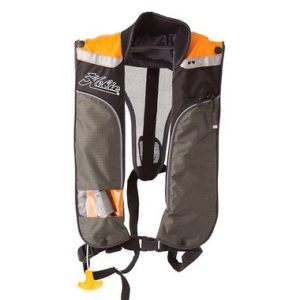 9 out of 10 drownings happen on inland water, well within rescue distance. Most victims owned a Life Jacket (properly called a Personal Flotation Device or PFD), but weren’t wearing it when they drowned. Owning a PFD is not enough. You must wear it every time you are on the water. Each time you don’t wear it, the odds are against you. Today’s PFDs are far more comfortable than the old orange generic ones you may have seen at summer camp. There are a ton of PFDs on the market and they all serve different functions. Which one should you get?
9 out of 10 drownings happen on inland water, well within rescue distance. Most victims owned a Life Jacket (properly called a Personal Flotation Device or PFD), but weren’t wearing it when they drowned. Owning a PFD is not enough. You must wear it every time you are on the water. Each time you don’t wear it, the odds are against you. Today’s PFDs are far more comfortable than the old orange generic ones you may have seen at summer camp. There are a ton of PFDs on the market and they all serve different functions. Which one should you get?
The U.S. Coast Guard splits PFDs into three categories, plus a few speciality PFDs.
Type I: Best for all waters, open ocean, rough seas, or remote water, where rescue may be slow coming.
Type II: For general boating activities. Good for calm, inland waters, or where there is a good chance for fast rescue.
Type III: For general boating or the specialized activity that is marked on the device such as water skiing, hunting, fishing, canoeing, kayaking and others. Good for calm, inland waters, or where there is a good chance for fast rescue. Designed so that wearing it will complement your boating activities:
Most PFDs you find at retail stores like Gig Harbor Watersports are Type III and we have selected the ideal pfd’s for our local water activities. There are two broad categories within Type III floatation aids.
Inflatables

Hobie’s Inflatable Belt Pack, deployed by rip cord
Most inflatable PFDs on the market are powered by a CO2 cartridge to inflate. The cartridge inflates when the user pulls a rip cord (the yellow t-handle in the pictures). These come in either a waist version, or a more traditional style. There are also inflatables that activate when they come in contact with water. A dissolvable bobbin with a spring/pin arrangement punctures the CO2 cartridge and inflates the PFD. The last type of inflatable in orally inflated.
The biggest disadvantage of the inflatables is that they require far more maintenance to ensure they work properly. There is a higher risk of malfunction. Lastly, if you use the rip-cord style, the assumption is that you will be able to pull the rip cord. In an emergency this isn’t always the case. We suggest the inflatables to people with experience who are on calm water.
Traditional

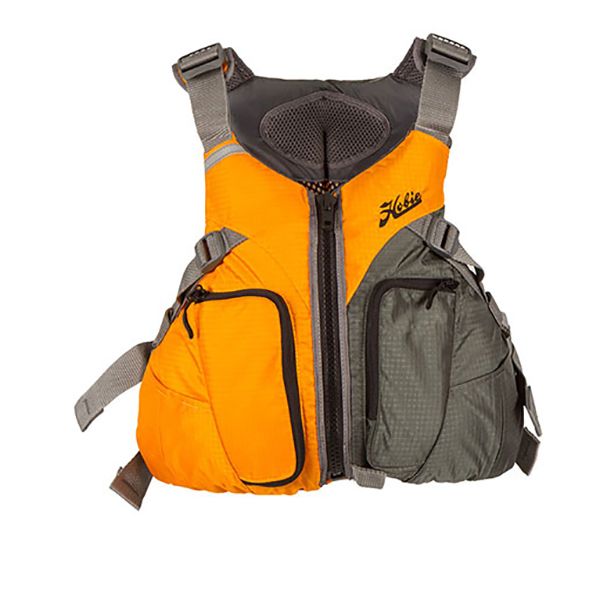 These PFDs generally use buoyant foam to help the user stay afloat. In recent years companies have made a huge effort to make these PFDs comfortable and breathable. Fishing specific PFDs come with extra pockets and mesh to help with tackle management. Hobie has released PFDs that ride higher than traditional devices to ensure that there is no annoyance when using their Mirage Drive system. We suggest this type of PFD for most users. It will keep you afloat even if you can’t pull a rip cord in an emergency.
These PFDs generally use buoyant foam to help the user stay afloat. In recent years companies have made a huge effort to make these PFDs comfortable and breathable. Fishing specific PFDs come with extra pockets and mesh to help with tackle management. Hobie has released PFDs that ride higher than traditional devices to ensure that there is no annoyance when using their Mirage Drive system. We suggest this type of PFD for most users. It will keep you afloat even if you can’t pull a rip cord in an emergency.
If you plan on tackling rough, remote, or open waters where rescue may be a long time coming, you should invest in a Type I PFD that will flip you right side up even if unconscious and keep you in that position. For most of us doing most recreational activities a Type II or Type III is a perfect, comfortable solution to help keep you safe without encumbering the activity.
When you’re looking for a new kayak, you will inevitably see a slough of names of plastics and manufacturing techniques. It’s easy to get lost in the terminology. Let’s break it down quickly.
There are three basic types of kayaks: fiberglass, or plastics made with a rotomolded or thermoformed technique. Many racing and ocean kayaks are made of fiberglass, but as you move into recreational and fishing kayaks you will begin to primarily see the other two types. All of our kayaks are either rotomolded or thermoformed.
Rotomolded
Hobie and Native Watercraft kayaks are rotomolded plastic kayaks. These kayaks start with powdered polyethylene plastic and a mold. First, any graphics are placed directly on the mold. Secondly, the plastic powder is laid by hand into a female mold. Because the plastics are laid by hand, the multicolored patterns you see in the new camo Hobie or in the Native kayaks are unique to that boat. The mold is the clamped shut and the whole mold is moved into an oven. The mold is consistently moved, rotated, rocked, and agitated to ensure even distribution of the plastic. After 30 minutes or so, the kayak is moved out of the oven and allowed to cool. All the fittings, hatches, etc. are now added and the kayak moves on to quality control where it is tested to ensure that it lives up to the standard you expect.
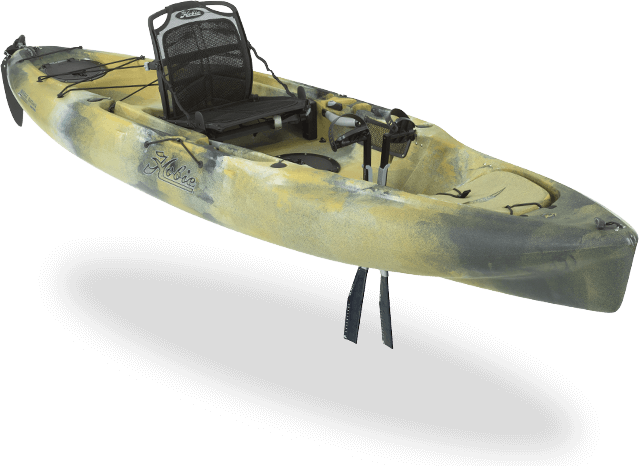
A rotomolded Hobie Mirage Outback in Camo color.
Thermoformed
Thermoformed kayaks start with a sheet of plastic. This plastic sheet is generally made up of several types of plastics compressed into one sheet. For most producers, the outside layer is an acrylic plastic of some kind. This layer is meant to protect the kayak from harmful UV rays as well as create a glossy finish and attractive color. The inner layer that forms the kayak is an high impact ABS plastic. This gives the kayak rigidity and allows it to take a beating on the water.
The sheet of plastic is heated in an oven, and moved on top of a male mold that’s already been stickered and branded. A vacuum is then applied and the sheet forms to the mold. This is allowed to cool, and then the excess plastic is cut off and recycled into a new sheet. The top and bottom of the kayak are then joined together, and the fittings, hatches, etc. are added.

A thermoformed Hurricane Santee 120 Sport.
With proper care, both kayaks will last for years. So what is the advantage of each method?
Rotomolded kayaks tend to be heavier, however they take a beating much better than a thermoformed kayak. Rotomolded kayaks also do not have a built in protection against UV rays. You’ll find that most fishing boats are made out of rotomolded plastic.
Thermoformed kayaks are much lighter weight. They also aren’t as durable as rotomolded kayaks. For many recreational kayakers in the Puget Sound, thermoformed is a great fit. It is lightweight and sharp rocks and debris aren’t as much as a problem as they are for people using the boats on rivers or sharp, rocky shores. Thermoformed is a great fit for recreational kayakers coming from fiberglass and wanting a lightweight option at a competitive price point.
We stock kayaks made from both rotomolded or thermoformed ABS. We’d love to show you the difference in person. Come by to see for yourself.
The festivities start Friday at noon with Olympic swimmer, Amanda Beard, Christening a kayak with a beer! We have some excellent guest speakers, food, and beer. Come on down and check out the new store! It is only two doors down from the fly shop, next to the park!
Schedule:
Friday
12pm – Grand Opening Ceremony
12-6pm – Open hours, Hors d’oeuvres, fancy cookies, and giveaways.
4pm – Happy Hour
Saturday
9-6pm – Open hours, Hors d’oeuvres, fancy cookies, and giveaways.
11am – Free Seminar – Dick Wark (Gig Harbor Watersports Hobie Fishing Team Member) – Kayak Fishing for Salmon & Bottom Fishing from Ocean to Estuary
1pm – Free Seminar – Brad Hole (Regional Hobie Fishing Team Member) – Trolling Lead Core Line for Local Lakes
4pm – Happy Hour
Sunday
9-6pm – Open Hours, Hors d’oeuvres, fancy cookies, and giveaways.
1pm – Free Seminar – Bryant Hawkins (Gig Harbor Watersports) – Paddles! Choosing, sizing, and using the right paddle.
4pm – Happy Hour